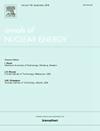Influence of narrow gaps between the adjacent components on graphite lifetime in molten salt reactors
IF 1.9
3区 工程技术
Q1 NUCLEAR SCIENCE & TECHNOLOGY
引用次数: 0
Abstract
As one of the prospective Generation IV reactor designs, molten salt reactors (MSRs) are receiving increasing attention due to its unique advantages. Graphite is a preferred moderator in an MSR with the excellent moderation capability, good compatibility with the fuel salt and the stability under neutron radiation. However, the narrow gaps filled with fuel salt are existed between adjacent graphite assemblies due to the fabrication tolerances, the irradiation-induced deformation, and the different thermal expansion coefficients between the support structure and graphite. As the fuel salt acts as both a heat source and coolant, the effect of narrow gaps on the component performance and their impact on graphite lifespan is necessary to be evaluated. This study analyzes the specific effects of narrow gaps between the adjacent graphite components in a round channel assembly (RCA) and round groove assembly (RGA) of a small modular molten salt reactor (SM-MSR), respectively. The results show that the performances of graphite assemblies with the narrow gaps significantly differ from those of ideal assemblies with no gaps. In terms of the component structure, the variations on the neutronic and thermohydraulic performances between RGA and RCA are primarily caused by the distinct positions of the narrow gap in each component. One the one hand, the heat flux distribution indicates that the component structures have a significant impact on the overall cooling capacity, where RGA exhibited a more than 19.98 % reduction in the heat removal through the primary channel to the graphite compared to RCA with a 0.5 mm narrow gap. The effective cooling range extends from inlet to the outlet with the increased narrow gap width. On the other hand, the flow exchange between the fuel salt in channels is enhanced in RGA due to the connectivity of the primary and narrow gap channels. Furthermore, the hotspot in the component is mitigated by the increase in the mass flow rate of fuel salt through the narrow gap flow channel, which is more prominent with the widening of the narrow gap. Therefore, the adverse effects on the temperature distribution caused by the narrow gap can be alleviated in RGA compared to RCA. Due to the enhanced flow when the narrow gap width is increased from 0.5 mm to 3 mm, the temperature gradient is decreased by 68.56 % and 62.38 % for RCA and RGA, respectively. The graphite lifetime is also evaluated under the considerations of narrow gap width and component structure. When the narrow gap width is expanded to be 3 mm, the graphite lifetime of RGA is observed to be 7.47 % longer than that of RCA. The component lifespan is slightly improved with the increased width of the narrow gap. For the narrow gap width of 0.5 mm, the lifespan of RCA and RGA is reduced by 30.88 % and 22.43 %, respectively, compared to the ideal assembly with no narrow gap. Furthermore, when the narrow gap width of RGA reached to be 3 mm, the graphite lifespan is superior to that of the ideal component.
求助全文
约1分钟内获得全文
求助全文
来源期刊

Annals of Nuclear Energy
工程技术-核科学技术
CiteScore
4.30
自引率
21.10%
发文量
632
审稿时长
7.3 months
期刊介绍:
Annals of Nuclear Energy provides an international medium for the communication of original research, ideas and developments in all areas of the field of nuclear energy science and technology. Its scope embraces nuclear fuel reserves, fuel cycles and cost, materials, processing, system and component technology (fission only), design and optimization, direct conversion of nuclear energy sources, environmental control, reactor physics, heat transfer and fluid dynamics, structural analysis, fuel management, future developments, nuclear fuel and safety, nuclear aerosol, neutron physics, computer technology (both software and hardware), risk assessment, radioactive waste disposal and reactor thermal hydraulics. Papers submitted to Annals need to demonstrate a clear link to nuclear power generation/nuclear engineering. Papers which deal with pure nuclear physics, pure health physics, imaging, or attenuation and shielding properties of concretes and various geological materials are not within the scope of the journal. Also, papers that deal with policy or economics are not within the scope of the journal.
 求助内容:
求助内容: 应助结果提醒方式:
应助结果提醒方式:


